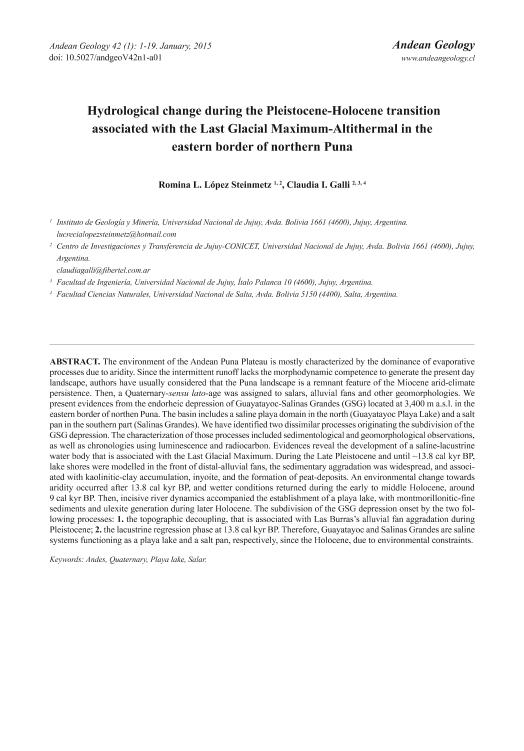Mostrar el registro sencillo del ítem
dc.contributor.author
López Steinmetz, Romina Lucrecia

dc.contributor.author
Galli, Claudia Inés

dc.date.available
2018-03-07T17:27:28Z
dc.date.issued
2015-01
dc.identifier.citation
López Steinmetz, Romina Lucrecia; Galli, Claudia Inés; Hydrological change during the pleistocene-holocene transition associated with the last glacial maximum-altithermal in the eastern border of northern Puna; Servicio Nacional de Geología y Minería; Andean Geology; 42; 1; 1-2015; 1-19
dc.identifier.issn
0718-7092
dc.identifier.uri
http://hdl.handle.net/11336/38126
dc.description.abstract
The environment of the Andean Puna Plateau is mostly characterized by the dominance of evaporative processes due to aridity. Since the intermittent runoff lacks the morphodynamic competence to generate the present day landscape, authors have usually considered that the Puna landscape is a remnant feature of the Miocene arid-climate persistence. Then, a Quaternary-sensu lato-age was assigned to salars, alluvial fans and other geomorphologies. We present evidences from the endorheic depression of Guayatayoc-Salinas Grandes (GSG) located at 3,400 m a.s.l. in the eastern border of northen Puna. The basin includes a saline playa domain in the north (Guayatayoc Playa Lake) and a salt pan in the southern part (Salinas Grandes). We have identified two dissimilar processes originating the subdivision of the GSG depression. The characterization of those processes included sedimentological and geomorphological observations, as well as chronologies using luminescence and radiocarbon. Evidences reveal the development of a saline-lacustrine water body that is associated with the Last Glacial Maximum. During the Late Pleistocene and until ~13.8 cal kyr BP, lake shores were modelled in the front of distal-alluvial fans, the sedimentary aggradation was widespread, and associated with kaoliniticclay accumulation, inyoite, and the formation of peat-deposits. An environmental change towards aridity occurred after 13.8 cal kyr BP, and wetter conditions returned during the early to middle Holocene, around 9 cal kyr BP. Then, incisive river dynamics accompanied the establishment of a playa lake, with montmorillonitic-fine sediments and ulexite generation during later Holocene. The subdivision of the GSG depression onset by the two following processes: 1. the topographic decoupling, that is associated with Las Burras’s alluvial fan aggradation during Pleistocene; 2. the lacustrine regression phase at 13.8 cal kyr BP. Therefore, Guayatayoc and Salinas Grandes are saline systems functioning as a playa lake and a salt pan, respectively, since the Holocene, due to environmental constraints.
dc.format
application/pdf
dc.language.iso
eng
dc.publisher
Servicio Nacional de Geología y Minería

dc.rights
info:eu-repo/semantics/openAccess
dc.rights.uri
https://creativecommons.org/licenses/by/2.5/ar/
dc.subject
Andes
dc.subject
Playa Lake
dc.subject
Quaternary
dc.subject
Salar
dc.subject.classification
Meteorología y Ciencias Atmosféricas

dc.subject.classification
Ciencias de la Tierra y relacionadas con el Medio Ambiente

dc.subject.classification
CIENCIAS NATURALES Y EXACTAS

dc.title
Hydrological change during the pleistocene-holocene transition associated with the last glacial maximum-altithermal in the eastern border of northern Puna
dc.title
Cambio hidrológico asociado al Último Máximo Glacial-Altitermal durante la transición Pleistoceno-Holoceno en el borde oriental de Puna Norte
dc.type
info:eu-repo/semantics/article
dc.type
info:ar-repo/semantics/artículo
dc.type
info:eu-repo/semantics/publishedVersion
dc.date.updated
2018-03-02T14:08:02Z
dc.identifier.eissn
0718-7106
dc.journal.volume
42
dc.journal.number
1
dc.journal.pagination
1-19
dc.journal.pais
Chile

dc.journal.ciudad
Santiago de Chile
dc.description.fil
Fil: López Steinmetz, Romina Lucrecia. Universidad Nacional de Jujuy. Instituto de Geología Minera; Argentina. Consejo Nacional de Investigaciones Científicas y Técnicas. Centro de Investigaciones y Transferencia de Jujuy. Universidad Nacional de Jujuy. Centro de Investigaciones y Transferencia de Jujuy; Argentina. Consejo Nacional de Investigaciones Científicas y Técnicas; Argentina
dc.description.fil
Fil: Galli, Claudia Inés. Consejo Nacional de Investigaciones Científicas y Técnicas. Centro de Investigaciones y Transferencia de Jujuy. Universidad Nacional de Jujuy. Centro de Investigaciones y Transferencia de Jujuy; Argentina. Universidad Nacional de Jujuy. Facultad de Ingeniería; Argentina. Universidad Nacional de Salta. Facultad de Ciencias Naturales; Argentina
dc.journal.title
Andean Geology

dc.relation.alternativeid
info:eu-repo/semantics/altIdentifier/url/http://www.scielo.cl/pdf/andgeol/v42n1/art01.pdf
dc.relation.alternativeid
info:eu-repo/semantics/altIdentifier/doi/http://dx.doi.org/10.5027/andgeoV42n1-a01
dc.relation.alternativeid
info:eu-repo/semantics/altIdentifier/url/http://www.andeangeology.cl/index.php/revista1/article/view/V42n1-a01
dc.relation.alternativeid
info:eu-repo/semantics/altIdentifier/url/http://www.redalyc.org/articulo.oa?id=173936233001
Archivos asociados
